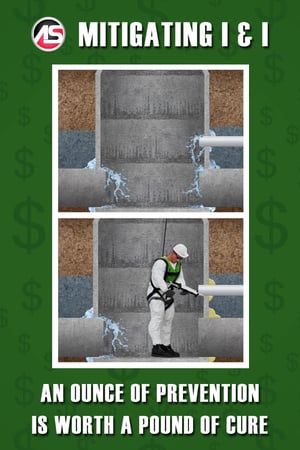
 Inflow and infiltration (I & I) are widespread problems for municipalities across North America. The term inflow refers to stormwater entering sewer systems. The term infiltration refers to groundwater leaking into manholes, lift stations, pipes, and other sanitary system components. While there are some methodologies on the market for mitigating inflow, this article is primarily concerned with mitigating infiltration with polyurethane grout.
Inflow and infiltration (I & I) are widespread problems for municipalities across North America. The term inflow refers to stormwater entering sewer systems. The term infiltration refers to groundwater leaking into manholes, lift stations, pipes, and other sanitary system components. While there are some methodologies on the market for mitigating inflow, this article is primarily concerned with mitigating infiltration with polyurethane grout.
Dangers Posed by Sanitary Sewer Overflows (SSOs)
According to EPA.gov, sanitary sewer overflows are widespread and pose many dangers to public health:
- The EPA estimates there are at least 23,000 - 75,000 SSOs per year (not including sewage backups into buildings) in the U.S. SSOs that reach waters of the U.S. are point source discharges. Like other point source discharges from municipal sanitary sewer systems, SSOs are prohibited unless authorized by a NPDES permit. Moreover, SSOs, including those that do not reach waters of the U.S., may be indicative of improper operation and maintenance of the sewer systems, and may violate NPDES permit conditions. (Source.)
- Because SSOs contain raw sewage they carry bacteria, viruses, protozoa (parasitic organisms), helminths (intestinal worms), and inhaled molds and fungi. As a result, they may cause diseases ranging in severity from mild gastroenteritis (causing stomach cramps and diarrhea) to life-threatening ailments such as cholera, dysentery, infections hepatitis, and severe gastroenteritis. People may be exposed through:
- Sewage in drinking water sources.
- Direct contact in areas of high public access such as basements, lawns or streets, or waters used for recreation. At least one study has estimated a direct relationship between gastrointestinal illness contracted while swimming and bacteria levels in the water.
- Shellfish harvested from areas contaminated by raw sewage. One study indicates that an average of nearly 700 cases of illness per year were reported in the 1980s from eating shellfish contaminated by sewage and other sources. The number of unreported cases is estimated to be 20 times that.
- Some cases of disease contracted through inhalation and skin absorption have also been documented. (Source.)
Massive Amount of Funds in Place for Sewer & Stormwater Infrastructure Repair
Fortunately, hundreds of billions of dollars are available for addressing these issues according to EPA.gov:
-
The CWSRF (Clean Water State Revolving Fund) was created by the 1987 amendments to the Clean Water Act (CWA) as a financial assistance program for a wide range of water infrastructure projects, under 33 U.S. Code §1383. The program is a powerful partnership between EPA and the states that replaced EPA's Construction Grants program. States have the flexibility to fund a range of projects that address their highest priority water quality needs. The program was amended in 2014 by the Water Resources Reform and Development Act. Using a combination of federal and state funds, state CWSRF programs provide loans to eligible recipients to:
-
construct municipal wastewater facilities,
-
control nonpoint sources of pollution,
-
build decentralized wastewater treatment systems,
-
create green infrastructure projects,
-
protect estuaries, and
-
fund other water quality projects.
-
- Building on a federal investment of $46.8 billion, the state CWSRFs have provided $145 billion to communities through 2020. States have provided over 42,800 low-interest loans to protect public health, protect valuable aquatic resources, and meet environmental standards benefiting hundreds of millions of people. (Source.)
A Simple Plan for Mitigating Sanitary/Stormwater System Infiltration
The grouting plan outlined below provides the highest return on investment:
- Inspect manhole and lift stations.
- Identify large, obvious leaks.
- Repair with polyurethane leak seal grout. A two-person crew can easily mitigate 10-30 gallons per hour in less than a day. This one day’s work typically equates to $30,000 a year in savings depending on local treatment costs.
For more information on mitigating infiltration with polyurethane grouts, call the Alchemy-Spetec technical support team at 404-618-0438 today.


